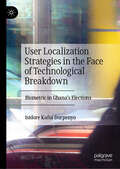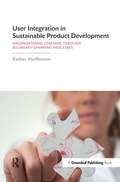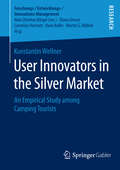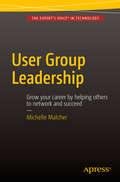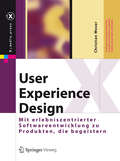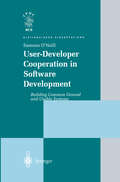- Table View
- List View
User Modeling for Multimedia Interfaces: Studies in Text and Graphics Understanding (Studien zur Kognitionswissenschaft)
by Susanne Mulken VanSusanne van Mulken develops a system module which - on the basis of Bayesian networks - is able to estimate the decodability of planned presentations for an individual user.
User Modeling, Adaption, and Personalization: 21th International Conference, UMAP 2013, Rome, Italy, June 10-14, 2013. Proceedings (Lecture Notes in Computer Science #7899)
by Sandra Carberry Stephan Weibelzahl Alessandro Micarelli Giovanni SemeraroThis book constitutes the thoroughly refereed proceedings of the 21st International Conference on User Modeling, Adaption, and Personalization, held in Rome, Italy, in June 2013. The 21 long and 7 short papers of the research paper track were carefully reviewed and selected from numerous submissions. The papers cover the following topics: recommender systems, student modeling, social media and teams, human cognition, personality, privacy, web curation and user profiles, travel and mobile applications, and systems for elderly and disabled individuals.
User Modeling, Adaptation and Personalization: 22nd International Conference, UMAP 2014, Aalborg, Denmark, July 7-11, 2014. Proceedings (Lecture Notes in Computer Science #8538)
by Vania Dimitrova Tsvi Kuflik David Chin Francesco Ricci Peter Dolog Geert-Jan HoubenThis book constitutes the thoroughly refereed proceedings of the 22nd International Conference on User Modeling, Adaption and Personalization, held in Aalborg, Denmark, in July 2014. The 23 long and 19 short papers of the research paper track were carefully reviewed and selected from 146 submissions. The papers cover the following topics: large scale personalization, adaptation and recommendation; Personalization for individuals, groups and populations; modeling individuals, groups and communities; Web dynamics and personalization; adaptive web-based systems; context awareness; social recommendations; user experience; user awareness and control; Affective aspects; UMAP underpinning by psychology models; privacy; perceived security and trust; behavior change and persuasion.
User Modeling, Adaptation, and Personalization: 20th International Conference, UMAP 2012, Montreal, Canada, July 16-20, 2012 Proceedings (Lecture Notes in Computer Science #7379)
by Judith Masthoff Bamshad Mobasher Michel Desmarais Roger NkambouThis book constitutes the refereed proceedings of the 20 th International Conference on User Modeling, Adaptation, and Personalization, held in Montreal, Canada, in July 2012. The 22 long and 7 short papers of the Research Paper Track presented were carefully reviewed and selected from 101 submissions. The papers are organized in topical sections on user engagement; trust; user motivation, attention, and effort; recommender systems (including topics such as matrix factorization, critiquing, noise and spam in recommender systems); user centered design and evaluation; educational data mining; modeling learners; user models in microblogging; and visualization. The Industry Paper Track covered innovative commercial implementations or applications of UMAP technologies, and experience in applying recent research advances in practice. 2 long and 1 short papers were accepted of 5 submissions.
User Modeling, Adaptation and Personalization: 23rd International Conference, UMAP 2015, Dublin, Ireland, June 29 -- July 3, 2015. Proceedings (Lecture Notes in Computer Science #9146)
by Francesco Ricci Kalina Bontcheva Owen Conlan Séamus LawlessThis book constitutes the refereed proceedings of the 23rd International Conference on User Modeling, Adaptation and Personalization, UMAP 2015, held in Dublin, Ireland, in June/July 2015.The 25 long and 7 short papers of the research paper track were carefully reviewed and selected from 112 submissions. The papers reflect the conference theme "Contextualizing the World", highlighting the significance and impact of user modeling and adaptive technologies on a large number of everyday application areas such as: intelligent learning environments, recommender systems, e-commerce, advertising, personalized information retrieval and access, digital humanities, e-government, cultural heritage, and personalized health.
User Localization Strategies in the Face of Technological Breakdown: Biometric in Ghana’s Elections
by Isidore Kafui DorpenyoThis book examines Ghana’s use of the fingerprint biometric technology in order to further conversations about localization championed by technical communication scholars. Localization, in this case, refers to the extent to which users demonstrate their knowledge of use by subverting and reconfiguring the purpose of technology to solve local problems. Dorpenyo argues that the success of a technology depends on how it meets the users’ needs and the creative efforts users put into use situations. In User Localization Strategies in the Face of Technological Breakdown, Dorpenyo advocates studying how users of technological systems construct knowledge about the technology and develop local strategies to solve technological breakdowns. By analyzing technical documents and interview transcripts, the author identifies and advances three user localization strategies: linguistic localization, subversive localization, and user-heuristic experience localization, and considers how biometric systems can become a tool of marginalization.
User Integration in Sustainable Product Development: Organisational Learning through Boundary-Spanning Processes
by Esther HoffmannChanges in production and consumption patterns are a crucial element in advancing the sustainability agenda. Many companies are now contributing to such efforts through a focus on sustainable innovation when developing new products and services. However, problematically, many such products fail as consumers reject them in the marketplace. User integration in product development is a well-suited approach to increase the usability and the marketability of new products. This book asks the following question: under what conditions can companies trigger sustainability-oriented organizational learning processes by integrating consumers in product development? The author analyses this question by studying a new approach called INNOCOPE (Innovating through consumer-integrated product development). The analysis is based on a process model of organizational learning, distinguishing different learning phases and related boundary-spanning activities. The case study shows that boundary spanning and communication with external actors may directly affect almost all phases of the organizational learning process. Depending on the organizational learning phase, specific boundary-spanning activities are identified that can be characterized as outside-in, inside-in or inside-out directed processes. Moreover, the book describes supportive conditions for user integration with regard to the company, the product, the users involved and the communication process, and provides managerial recommendations. User Integration in Sustainable Product Development sheds new light on the interaction between companies and users in innovation processes and how they relate to sustainable product development. Its focus on organizational learning at and across the boundaries of companies is original, stimulating, improves our understanding of user–producer interactions and distinguishes the book from other publications on the market. The book provides a hugely comprehensive overview of user integration in innovation processes: its advantages, problems and weaknesses, and the methods in which it is currently applied. This, along with a systematic analysis of organisational learning provides the reader with a complete understanding of what has to be considered when studying user-producer interactions from a company perspective and provides the basis for further improvements and company strategies to advance the take-up of sustainable products. The book will be essential reading for academics and practitioners involved with organizational learning, innovation studies, sustainable design and product development, and marketing.
User Integration in Sustainable Product Development: Organisational Learning through Boundary-Spanning Processes
by Esther HoffmannChanges in production and consumption patterns are a crucial element in advancing the sustainability agenda. Many companies are now contributing to such efforts through a focus on sustainable innovation when developing new products and services. However, problematically, many such products fail as consumers reject them in the marketplace. User integration in product development is a well-suited approach to increase the usability and the marketability of new products. This book asks the following question: under what conditions can companies trigger sustainability-oriented organizational learning processes by integrating consumers in product development? The author analyses this question by studying a new approach called INNOCOPE (Innovating through consumer-integrated product development). The analysis is based on a process model of organizational learning, distinguishing different learning phases and related boundary-spanning activities. The case study shows that boundary spanning and communication with external actors may directly affect almost all phases of the organizational learning process. Depending on the organizational learning phase, specific boundary-spanning activities are identified that can be characterized as outside-in, inside-in or inside-out directed processes. Moreover, the book describes supportive conditions for user integration with regard to the company, the product, the users involved and the communication process, and provides managerial recommendations. User Integration in Sustainable Product Development sheds new light on the interaction between companies and users in innovation processes and how they relate to sustainable product development. Its focus on organizational learning at and across the boundaries of companies is original, stimulating, improves our understanding of user–producer interactions and distinguishes the book from other publications on the market. The book provides a hugely comprehensive overview of user integration in innovation processes: its advantages, problems and weaknesses, and the methods in which it is currently applied. This, along with a systematic analysis of organisational learning provides the reader with a complete understanding of what has to be considered when studying user-producer interactions from a company perspective and provides the basis for further improvements and company strategies to advance the take-up of sustainable products. The book will be essential reading for academics and practitioners involved with organizational learning, innovation studies, sustainable design and product development, and marketing.
User Innovators in the Silver Market: An Empirical Study among Camping Tourists (Forschungs-/Entwicklungs-/Innovations-Management)
by Konstantin WellnerIn this study among camping tourists of all age groups between 19 and 86 years of age, Konstantin Wellner compares key characteristics regarding innovative behavior of different age groups. The focus of the analysis is on the so-called “Silver Market” segment (consumers of at least 55 years) which gains importance to the demographic shift. Generally, older users are still actively innovating, especially if it relates to age-specific improvements (e.g., comfort and compatibility to other equipment). Analysis by a Structural Equation Model showed that the most important determinant of innovative behavior for older users is technical expertise and that being relatively ahead of trends increases their dissatisfaction with existing products. Additional evidence was found that user with high use experience suffer from functional fixedness.
User Innovation in Healthcare: How Patients and Caregivers React Creatively to Illness (SpringerBriefs in Health Care Management and Economics)
by Francesco SchiavoneThis book explores in depth the phenomenon of user innovation in healthcare. In particular, the book sheds light on patient innovation, whereby patients and/or caregivers proactively develop and diffuse new products and services that provide health and quality of life benefits by addressing gaps in existing market offerings. The aim is to clarify the key characteristics of these innovative processes and to offer practitioners and policymakers tangible bottom-up evidence, solutions, and ideas that will assist in improving health systems, organizations, and practices. A number of important and interesting research questions are addressed, casting light on the types of products and services that tend to be developed by patient innovators, the typical profile of these innovators, the role played by firms, institutions, and health professionals, and the ways in which digital technologies support the dissemination of innovations among patient communities and within the industry. Beyond academic scholars and policymakers, the book will be of high value for students on master’s programs in both medical sciences and business and economics.
User Innovation Barriers’ Impact on User-Developed Products: An Empirical Investigation on User Innovation Processes (Forschungs-/Entwicklungs-/Innovations-Management)
by Thorsten PieperThorsten Pieper explores the impact of innovation barriers along the user innovation process, in particular whether technological, social, legal and ownership barriers change the properties of user-developed products. This study roots from the “open innovation” research field and reveals insights from innovating users in “collaborative workspaces”. The results prove a hierarchical allocation of innovation barriers regarding their influence on the end-product and moderating influences of user innovators’ personal characteristics. The author discusses these insights and provides practical recommendations for more efficient promotion of user innovations and successful integration in corporate "co-creation" projects.
User Guides, Manuals, and Technical Writing: A Guide to Professional English (Guides to Professional English)
by Adrian WallworkThis book is intended for anyone whose job involves writing formal documentation. It is aimed at non-native speakers of English, but should also be of use for native speakers who have no training in technical writing.Technical writing is a skill that you can learn and this book outlines some simple ideas for writing clear documentation that will reflect well on your company, its image and its brand.The book has four parts:Structure and Content: Through examples, you will learn best practices in writing the various sections of a manual and what content to include.Clear Unambiguous English: You will learn how to write short clear sentences and paragraphs whose meaning will be immediately clear to the reader.Layout and Order Information: Here you will find guidelines on style issues, e.g., headings, bullets, punctuation and capitalization.Typical Grammar and Vocabulary Mistakes: This section is divided alphabetically and covers grammatical and vocabulary issues that are typical of user manuals.
User Groups im Systemgeschäft: Ansatzpunkte für das Systemmarketing
by Susann K. ErichssonZur Reduktion hoher Investitionsrisiken haben sich Anwender innovativer Technologien in User Groups zusammengeschlossen. Dieses Buch zeigt wichtige Strukturmerkmale und Funktionen von User Groups und entwickelt konkrete Handlungsempfehlungen.
User Group Leadership
by Michelle MalcherThis book is about starting and sustaining a technology user group. User groups are a wonderful way to connect with local and like-minded professionals for networking and learning. All the forums and social media on the internet can’t replace face-to-face time spent discussing problems, upcoming technologies, and other pertinent topics. What every user group needs is leaders to organize meetings, find speakers, and connect the community.What every leader needs is good advice and guidance on how to begin a group and nurture new leadership to keep the group sustainable, and Michelle Malcher provides just that right sort of guidance in her book on User Group Leadership. This book is designed to help you understand what goes into starting and building a user group, giving you the tools and resources to do so. Learn what to expect before your first meeting, in the first three months, and in the first year.Malcher has experience from the local group level on up to the international level with the Independent Oracle User Group. If you’re involved in technology and are ready to take on a position of leadership by which to help others network, succeed, and grow, then grab a copy of this book. You won’t find a better source of guidance for starting and growing a new group on the technology of your choice.Learn what to know before you ever have your first meetingPrepare for each meeting with a list of things that should be doneGrow your local members into future leaders
User-Generated Content and its Impact on Branding: How Users and Communities Create and Manage Brands in Social Media
by Severin DennhardtThe emergence of social media as one of the driving forces of consumers’ online experiences today also challenges our current understanding on marketing and brand management. The effects of brands’ social media involvement are to this day uncertain. Severin Dennhardt shows that social media and user-generated brands do have a strong influence on brands. Four independent studies demonstrate that first, successful brands can be created in virtual worlds, second, user-generated content drives the creation of unique brands, third social media strongly influences the social value perception of brands, and fourth, social media impacts consumers’ purchase decision process.
User Generated Branding: Integrating User Generated Content into Brand Management (Innovatives Markenmanagement)
by Ulrike ArnholdFrom a brand management perspective Ulrike Arnhold analyses the impact of interactive marketing programmes in Web 2.0, evaluating user generated content as a tool of the brand communication mix.
User Experience Research: Discover What Customers Really Want
by Marty Gage Spencer MurrellThe Fuzzy Front End Gets Demystified in This Next-Generation User Research Guide The first phase of the design thinking process is arguably the most crucial, as this is when human insights are leveraged to define value for customers. Yet this so-called "empathize" phase is often deemed optional or is executed poorly. This degrades the entire innovation process that follows by permitting preexisting biases and guesswork that make value creation a precarious bet. In User Experience Research: Discover What Customers Really Want, a human factors psychologist and an industrial designer have devised a foolproof first phase that addresses the shortcomings of the design thinking process. Based on their forty years of generative research experience in multiple industries, this is the definitive guide to user experience research. This repeatable approach is grounded in six key principles that connects users’ desired emotional states to an actionable articulation of an experience. It also provides guidance on creating ideal experience frameworks that communicate clearly with all stakeholders, from business leaders to design practitioners. User Experience Research: Discover What Customers Really Want is an indispensable, fully illustrated, step-by-step manual for anyone seeking a more predictable pathway to the design of new or improved experiences that users truly desire and would find valuable.
User Experience Is Brand Experience: The Psychology Behind Successful Digital Products and Services (Management for Professionals)
by Felix van de Sand Anna-Katharina Frison Pamela Zotz Andreas Riener Katharina HollThis book offers a new method for aligning brand management and user experience goals. Brand management deals with conveying individual brand values at all marketing contact points, the goal being to reach the target group and boost customer retention. In this regard, it is important to consider the uniqueness of each brand and its identity so as to design pleasurable and high-quality user experiences. Combining insights from science and practice, the authors present a strategy for using interaction patterns, visual appearance, and animations to validate the actual brand values that are experienced by users while interacting with a digital product. Further, they introduce a 'UX identity scale' by assigning brand values to UX related psychological needs. The method applied is subsequently backed by theoretical concepts and illustrated with practical examples and case studies on real-world mobile applications.
User Experience Innovation: User Centered Design that Works
by Christian KraftUser Experience Innovation is a book about creating novel and engaging user experiences for new products and systems. User experience is what makes devices such as Apple's iPhone and systems such as Amazon.com so successful. iPhone customers don't buy just a phone; they buy into an experience enabled by the device. Similarly, Amazon.com customers enter a world of book reviews, interesting recommendations, instant downloads to their Kindle, and one-click purchasing. Products today are focal points, and it is the experience surrounding the product that matters the most. User Experience Innovation helps you create the right sort of experience around your products in order to be successful in the marketplace.The approach in User Experience Innovation is backed by 18 years of experience from an author holding more than 100 patents relating to user experience. This is a book written by a practitioner for other practitioners. You'll learn 17 specific methods for creating innovation; these methods run the gamut from targeting user needs to relieving pain points, to providing positive surprises, to innovating around paradoxes. Each method is one that the author has used successfully. Taken together, they can help you create truly successful user experience innovations to benefit your company or organization, and to help you grow as an experienced expert and innovator in your own right.Provides 17 proven methods for innovating around user experience Helps you think beyond the product to the sum total of a customer's experience Written by an experienced practitioner holding more than 100 user-experience patents
User Experience im E-Commerce: Messung von Emotionen bei der Nutzung interaktiver Anwendungen (Business - Innovation - High Tech)
by Oliver GastEmotionale Reaktionen von Nutzern auf Stimuli einer interaktiven Anwendung gelten als zentrale Indikatoren für positive oder negative User Experience. Oliver Gasts Untersuchung stellt ein Verfahren vor, das die Messung und Interpretation der Emotionen bei der Nutzung interaktiver Anwendungen ermöglicht. Denn der Erfolg von webbasierten Applikationen, wie z. B. Online-Shops, hängt in sehr hohem Maße von der Erfüllung der Erwartungen des einzelnen Nutzers ab. Mit den Ergebnissen seiner Untersuchung hat der Autor ein Modell erstellt und evaluiert, welches die relevanten Indikatoren für Mimik basierte Emotionsbewertung umfassend aufzeigt.
User Experience Identity: Mit Neuropsychologie digitale Produkte zu Markenbotschaftern machen
by Felix van de SandDieses Buch zeigt, wie eine nachhaltige User Experience an den digitalen Touchpoints einer Marke erzeugt werden kann. Die überzeugende und unverwechselbare Kommunikation einer Markenpersönlichkeit auf Websites, Mobile Sites, Apps und Landingpages führt direkt zu Wachstum in User Engagement, Conversion und ROI. An Praxisbeispielen führt der Autor anschaulich vor, wie die Erkenntnisse aus Neuropsychologie und Neuromarketing konkret in den Produktgestaltungsprozess und das User Experience Design übertragen werden können. Die wichtigsten Werkzeuge und Leistungsbausteine werden vorgestellt und ihre Anwendung verständlich erläutert.Ein empfehlenswertes Fachbuch für Produktmanager, CMO, UX Manager und Webentwickler, die den Mehrwert ihrer Marke mit einem stimmigen User Experience Design steigern wollen.
User Experience Design: A Practical Playbook to Fuel Business Growth
by Satyam KantamneniIgniting business growth through UX In an increasingly digital world, users are rewarding products and services that provide them with a good experience and punishing those that don’t — with their wallets. Organizations realize they need to adapt quickly but don’t know how or where to start. In User Experience Design: A Practical Playbook to Fuel Business Growth, UXReactor co-Founder Satyam Kantamneni distills 25 years of industry experience into a pragmatic approach to help organizations advance in the highly competitive and rapidly changing digital world. You’ll discover: Why putting users at the center of strategy leads to an almost unfair competitive advantage Ways to build an organizational system that delivers a superior user experience that is replicable, consistent, and scalable Common shortfalls that prevent organizations from reaping the value of experience design 27 proven “plays” from the UXReactor playbook to put concepts into practice Game planning examples to execute at different levels of an organization A comprehensive and practical book for everyone involved in the transformation — business leaders, design leaders, product managers, engineers, and designers — User Experience Design: A Practical Playbook to Fuel Business Growth is also an ideal blueprint for current and prospective UX practitioners seeking to improve their skills and further their careers.
User Experience Design: A Practical Playbook to Fuel Business Growth
by Satyam KantamneniIgniting business growth through UX In an increasingly digital world, users are rewarding products and services that provide them with a good experience and punishing those that don’t — with their wallets. Organizations realize they need to adapt quickly but don’t know how or where to start. In User Experience Design: A Practical Playbook to Fuel Business Growth, UXReactor co-Founder Satyam Kantamneni distills 25 years of industry experience into a pragmatic approach to help organizations advance in the highly competitive and rapidly changing digital world. You’ll discover: Why putting users at the center of strategy leads to an almost unfair competitive advantage Ways to build an organizational system that delivers a superior user experience that is replicable, consistent, and scalable Common shortfalls that prevent organizations from reaping the value of experience design 27 proven “plays” from the UXReactor playbook to put concepts into practice Game planning examples to execute at different levels of an organization A comprehensive and practical book for everyone involved in the transformation — business leaders, design leaders, product managers, engineers, and designers — User Experience Design: A Practical Playbook to Fuel Business Growth is also an ideal blueprint for current and prospective UX practitioners seeking to improve their skills and further their careers.
User Experience Design: Mit erlebniszentrierter Softwareentwicklung zu Produkten, die begeistern (X.media.press)
by Christian MoserFunktionalität allein reicht bei Internet- oder Desktop-Anwendungen heute nicht aus, das Benutzererlebnis ist zunehmend ein Schlüsselfaktor für den Markterfolg. Ein positives Benutzererlebnis entsteht aber nur dann, wenn im Entwicklungsprozess Benutzeranalyse, Verständnis für das Business und Design perfekt aufeinander abgestimmt sind. Das Buch bietet einen kompakten Einstieg in die Thematik und führt durch den gesamten Prozess: vom Design und der Businessanalyse bis zur Produkteinführung. Relevante Methoden werden einfach und verständlich erklärt.
User-Developer Cooperation in Software Development: Building Common Ground and Usable Systems (Distinguished Dissertations)
by Eamonn O'NeillThe topic of the research reported here is direct user participation in the task-based development of interactive software systems. Building usable software demands understanding and supporting users and their tasks. Users are a primary source of usability requirements and knowledge, since users can be expected to have intimate and extensive knowledge of themselves, their tasks and their working environment. Task analysis approaches to software development encourage a focus on supporting users and their tasks while participatory design approaches encourage users' direct, active contributions to software development work. However, participatory design approaches often concentrate their efforts on design activities rather than on wider system development activities, while task analysis approaches generally lack active user participation beyond initial data gathering. This research attempts an integration of the strengths of task analysis and user participation within an overall software development process. This work also presents detailed empirical and theoretical analyses of what it is for users and developers to cooperate, of the nature of user-developer interaction in participatory settings. Furthermore, it makes operational and assesses the effectiveness of user participation in development and the impact of user-developer cooperation on the resulting software product. The research addressed these issues through the development and application of an approach to task based participatory development in two real world development projects. In this integrated approach, the respective strengths of task analysis and participatory design methods complemented each other's weaker aspects.





